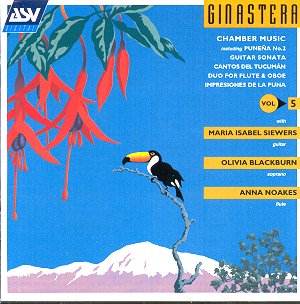Alberto GINASTERA (1916-1983)
Chamber music volume 5
Cantos del Tucuman for voice, harp, flute, and caja grande
(1938)
Danza Del Rigo (from Estancia) arranged for violin and
guitar by Zarate and
Triste Pampeano for solo guitar (from Estancia) transcribed
by by Salomon de Font (1943);
Guitar Sonata Op. 47 (1976);
Punena No 2 for solo cello Op45 (1976)
Duo for flute and oboe Op 13 (1945);
Danza Criolla (for solo guitar Op15no1 (arr.Barbosa-Lima) Milonga
(arr.Mercado) for solo Guitar;
Impresiones De La Puna for flute and string quartet.
 Olivia Blackburn (soprano)
Anna Noakes (flute) David Emanuel (violin) Gillian Tingay-(harp) Gary Kettel
(percussion) John Anderson (oboe) Christopher Van Kampen (Cello) Maria Isaebel
Siewers (guitar) Rafael Gintoli (Violin) Lyric String Quartet
Olivia Blackburn (soprano)
Anna Noakes (flute) David Emanuel (violin) Gillian Tingay-(harp) Gary Kettel
(percussion) John Anderson (oboe) Christopher Van Kampen (Cello) Maria Isaebel
Siewers (guitar) Rafael Gintoli (Violin) Lyric String Quartet
Recorded St.Silas Church Kilburn May 1995 and February 2000 DDD
 ASV DCA 1103
[59.07]
ASV DCA 1103
[59.07]
Crotchet
AmazonUK
AmazonUS

It was back in 1989 when ASV started to record the music of Ginastera, in
those days on LP though I am not sure why as CD came in first in 1983. We
now have reached Volume 5 of the chamber music. This company has been doing
sterling work in the promotion of Iberian and South American music. Composers
like Pujol and Montsalvatge have also featured. In line with the other four
issues in this series a mix of pieces form the composer's life has been put
on to this CD. Ginastera's career covered at least 40 years and these works
date from 1938 and the 1940s and then there is a jump to 1976 making a
fascinating contrast. To understand the gradual process of the composer's
development it would be a good idea to purchase Volume 2 in this series which
is the complete piano music. But this group makes a very enjoyable series
of pieces allowing listeners, if they so desire, to listen right through.
The song cycle ' Cantos Del Tucuman' is a delicious piece in what the composer
outlined as his period of 'objective nationalism'. The use of the drum known
as the caja grande give the third song a real ethnic feel, I was also reminded
of early Renaissance Spanish music as recorded by Jordi Savall. The texts,
which are provided, are by Rafael Sanchez who lived in the Tucuman region
of North-East Argentina.
The guitar works, except the sonata, come from a period in the forties, during
which the composer used a style he termed 'subjective nationalism'. One is
an arrangement for violin and piano of the Danza de Trigo from Estancia Op
8a. ASV recorded the orchestral ballet suite 'Estancia' on their 1989 disc,
and it is interesting to compare them. The melody and harmony are very similar
but the duet gives the piece a successful salon effect. The Duo Op. 13 is
a wonderful and deliberately contrapuntal work, the instruments crossing
and weaving. The booklet notes mentions Scarlatti as a mentor here.
The works from the 1970s are quite different, and come from Ginastera's period
of 'neo-expressionism'. If you are not familiar with works like the 3rd quartet
or the Cello sonata (already available) then these pieces will surprise.
Indeed when I played the first moments of 'Punena' for solo cello I felt
that it might be typically 'squeaky-gate' music of the '70s. But one should
always trust a great composer. This is an elusive but evocative piece. The
title refers to an area of Northwest Argentina, a flat land and mountainous.
It was commissioned by Paul Sacher and first played by Rostropovich. The
composer remarked " it's a recreation of the world of sounds of the Inca
Empire." Sadly this was Christopher van Kampen's last ever recording as he
died suddenly in the spring of 2000. He is in superb form. The recording
is a fine tribute to a man who did such a great deal for contemporary music.
The Guitar Sonata of 1976 is considered one of the great masterpieces for
the instrument. It is in 4 movements with some exciting percussive effects
in the Finale. Ginastera had been asked to write a solo guitar work many
years before. He was an experienced composer, 60 years old by this time,
and the skill and imagination he brings to bear on such a composition was
worth the wait. The disc ends with 'Impresiones de la puna' which is
three-movement work of 7 minutes duration, for flute and string quartet (1942).
It is astonishing to think that this is apparently a student work as it is
written with such facility. Amazingly, he withdrew it from his official work
list. I for one am delighted to make its acquaintance.
No purchaser of this disc will be disappointed. This is fine and very enjoyable
music, excellently performed with character and passion.
Gary Higginson

